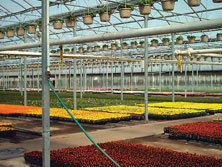2/21/2011
Managing Your Marigolds
Brian Bettinger
Marigolds have been a favorite of gardeners, landscapers and commercial growers for years. At Bettinger’s Farms in Ohio, we’ve grown marigolds since 1950, and are still offering them to independent garden centers. We currently grow 20,000 flats per season and offer 18 different varieties.
Marigolds are called half-hardy because they can stand some chill in the fall. Marigolds like full sun, but they can tolerate up to 20% shade if the light is still bright for the rest of the day. Hot, sunny, southern exposures promote the heaviest bloom. Marigolds will give more and better bloom in poor soil than in rich. Consumers love them because they bloom nonstop for virtually the entire summer.
Propagation
When sowing marigolds, I prefer to use a 288-cell tray filled with Berger BM2 germination mix. Marigold seeds are offered in three forms. I prefer to use a de-tailed coated seed that is yellow in color. We maintain soil temperature between 70F to 72F (21C to 22C) to initiate germination. Remove from bottom heat after germination. Maintain an air temperature of 68F (20C). Light is not required for germination. I like to maintain a 90% relative humidity until the cotyledons emerge. Allow three to four days for germination. Keep trays moist but not wet.
Once the marigold is established, we use a fungicide drench. Reduce moisture levels after germination, allowing the growing medium to dry out slightly before watering. I recommend using a water-soluble fertilizer such as 13-2-13 at 50 to 75 ppm nitrogen, maintaining an EC of 1.0 to 1.5. It takes about two weeks for plugs grown at 68F (20C) in 288-cell trays before moving to a 60F (15.5C) area. Once the plants are well-established and have a good root system, they’re ready to be transplanted. I adjust our daytime temperature to 65F (18C) and our nighttime temperature to 60F to 62F (15.5C to 17C). We keep our pH between 6.2 to 6.5 with a medium nutrient charge. Continue with the water-soluble fertilizer at 50 to 75 ppm nitrogen, maintaining an EC of 1.0.
Irrigation
Maintain even moisture. Do not allow plants to wilt. I prefer to hand water to be sure our plants have consistency.
Production
Marigolds are suitable for production in various size programs. We prefer 804s in traditional-sized flats. Marigolds perform well when grown in a moist, well-drained soil with a pH between 6.2 and 6.5 and a medium nutrient charge. For best quality, grow in production facilities with moderate to high light levels. When transplanting, take care to not bury the crown of the plant. After transplanting into the flats, the plug should be even with the soil surface; planting them too deep will lead to crop variability and losses. Ventilation is especially important when growing marigolds. Allow the soil to dry between irrigations, and provide good air circulation to allow the foliage to dry before sunset.

For the best quality, grow in production facilities with moderate to high light levels.
Growth regulators
Marigolds should not require growth regulators, but if necessary, use registered products at labeled rates. Rates will vary greatly with growing conditions. Temperature will control the height much more effectively than chemical controls. I recommend using B-Nine and I would apply it on a cloudy morning at 2,500 ppm, two weeks after transplanting to help tone the plants for their best appearance.
Insects and diseases
A very common problem with marigolds is damping off in the seedling stage. We recommend using Cleary’s 3336. Although marigolds can be produced relatively insect-free, aphids and whitefly often can be observed feeding on them. If this problem arises, I recommend using Orthene.
Tips
Invest in quality from the time you sow your seed through the production process to be sure you produce a high-quality finished product for your customer.
GT
Brian Bettinger is head grower of the Swanton Greenhouse Production Range at Bettinger Farms, Inc., in Swanton, Ohio. He can be reached at 419-829-2771 or www.bettingerfarms.com.